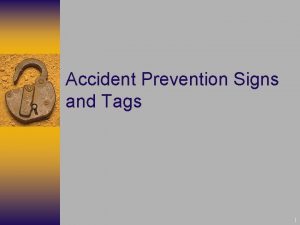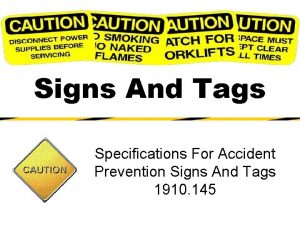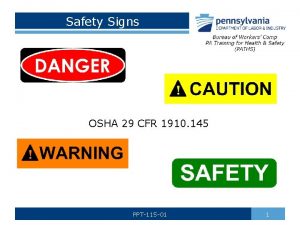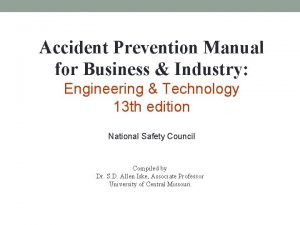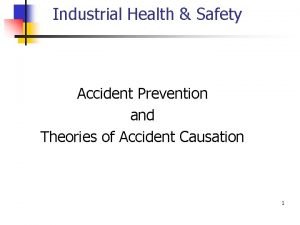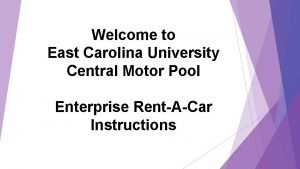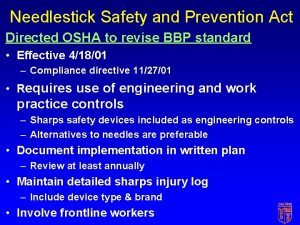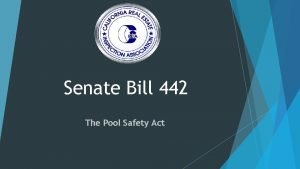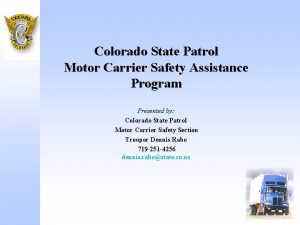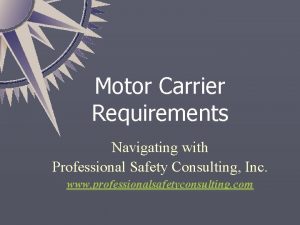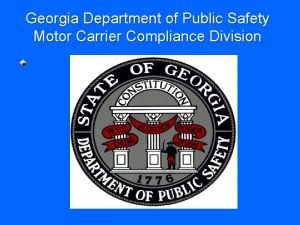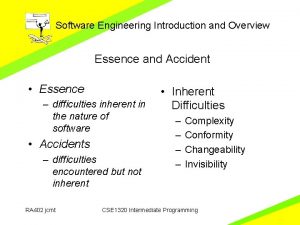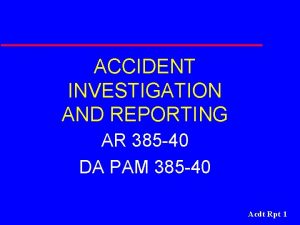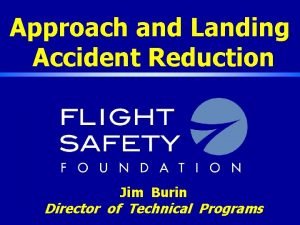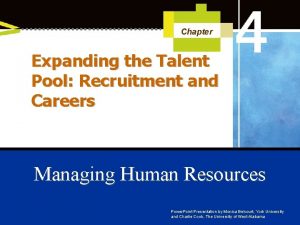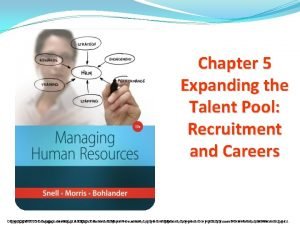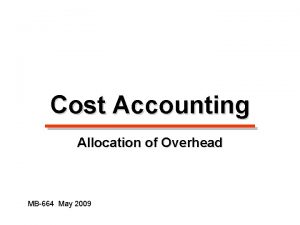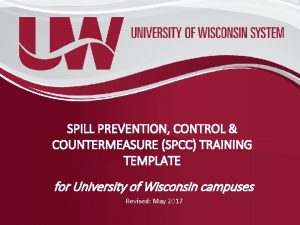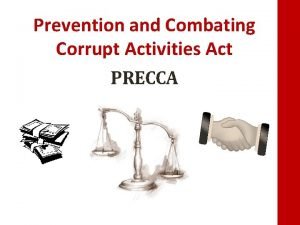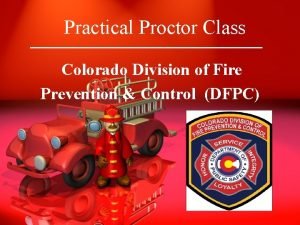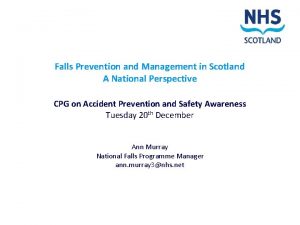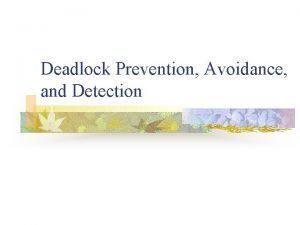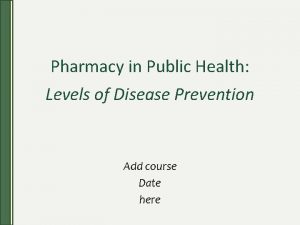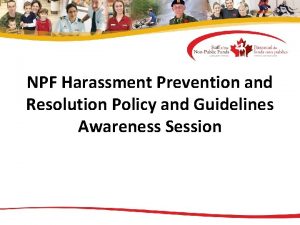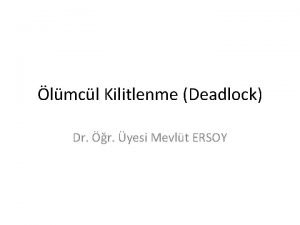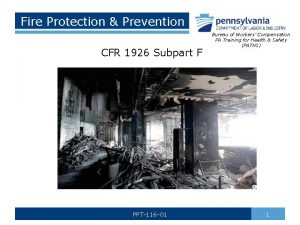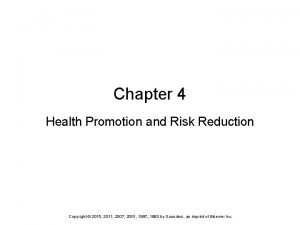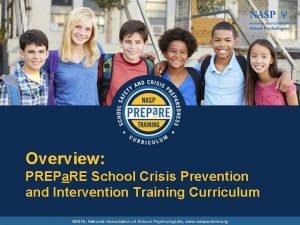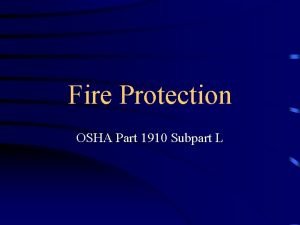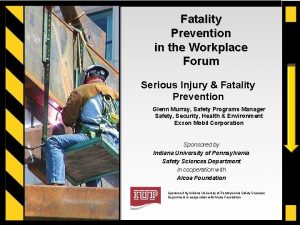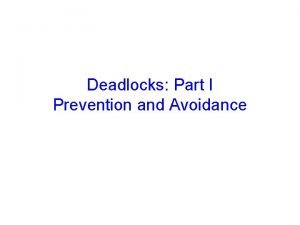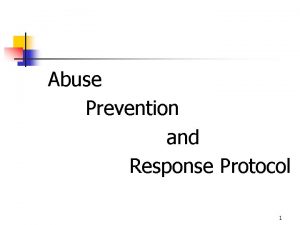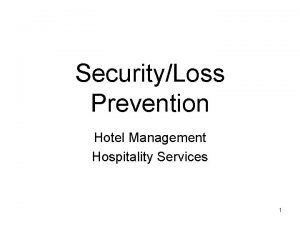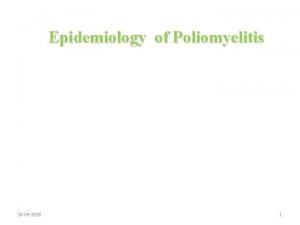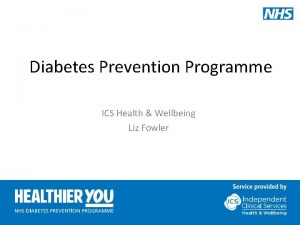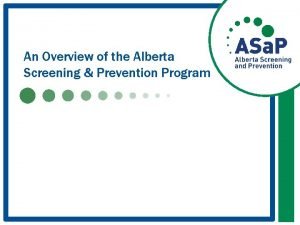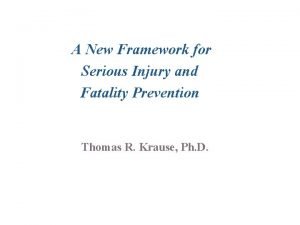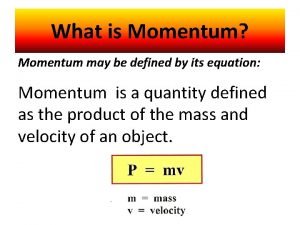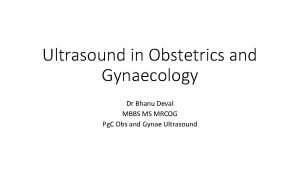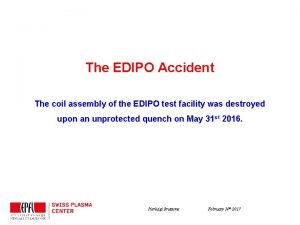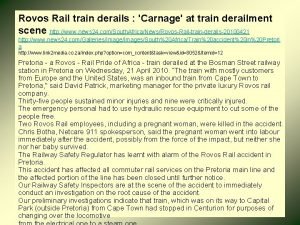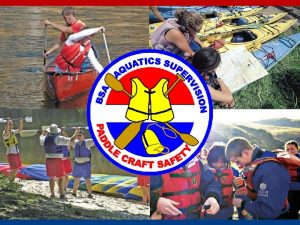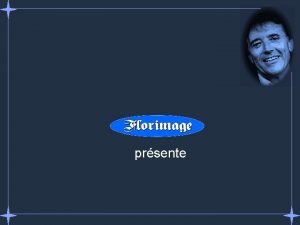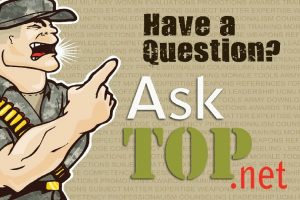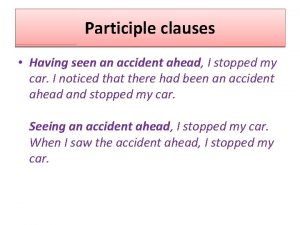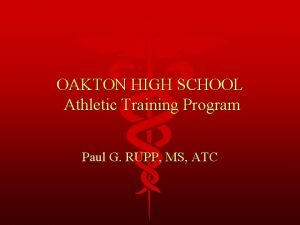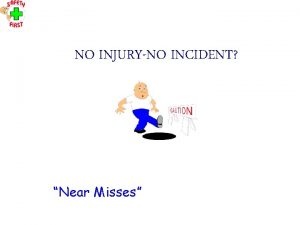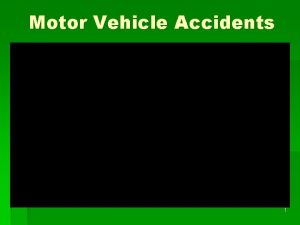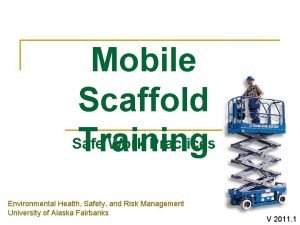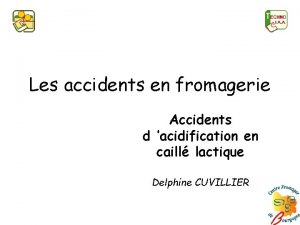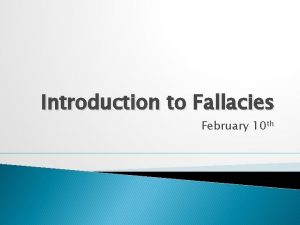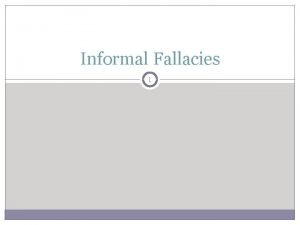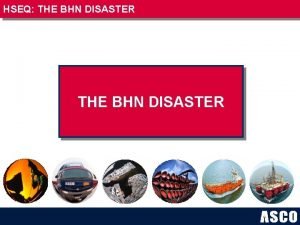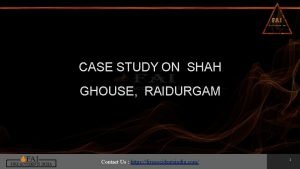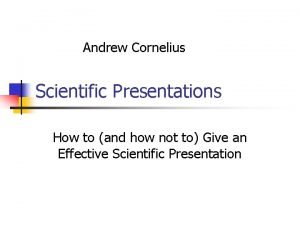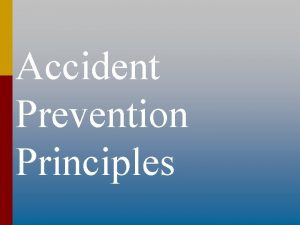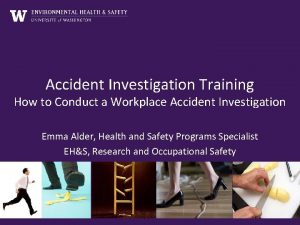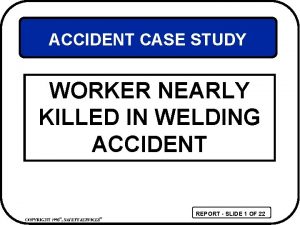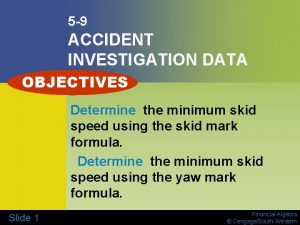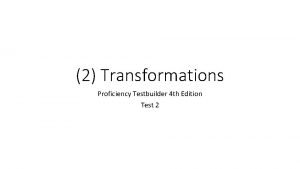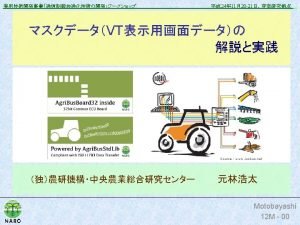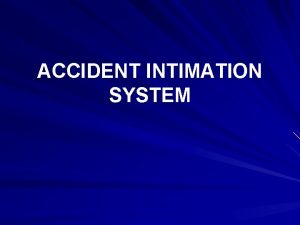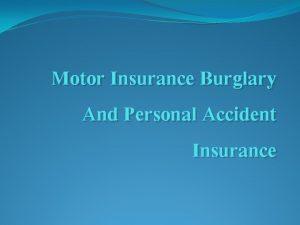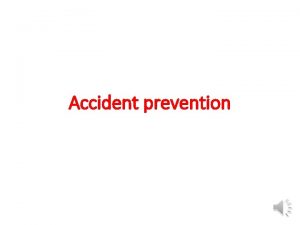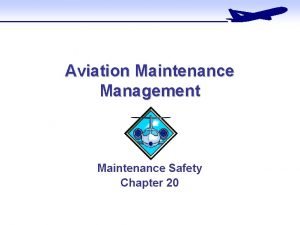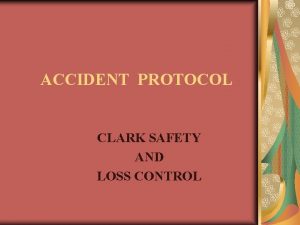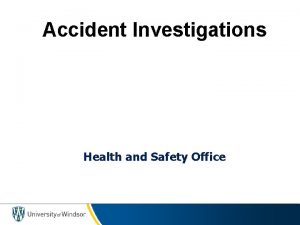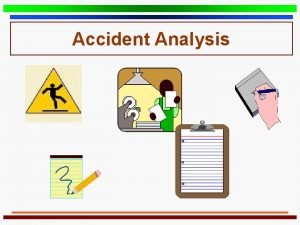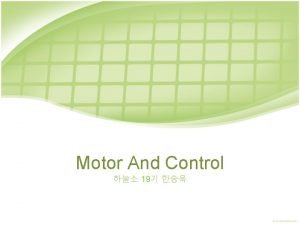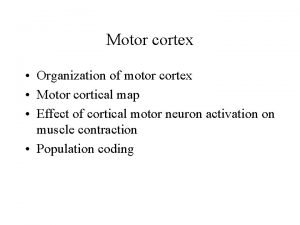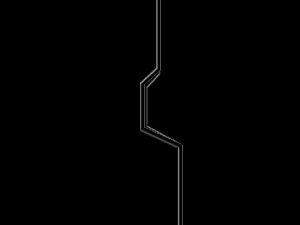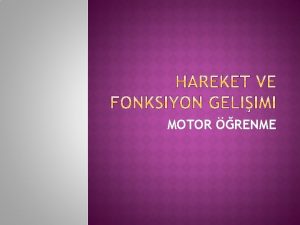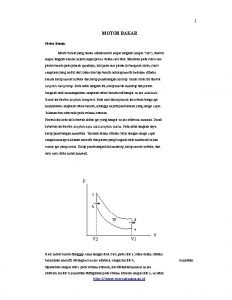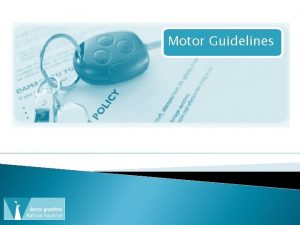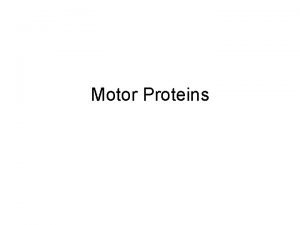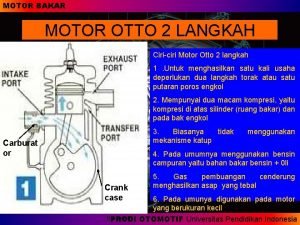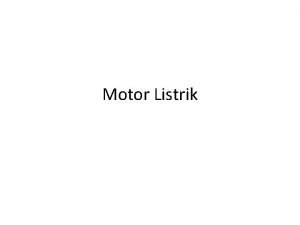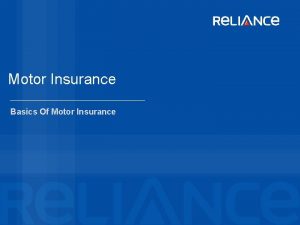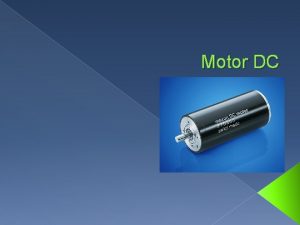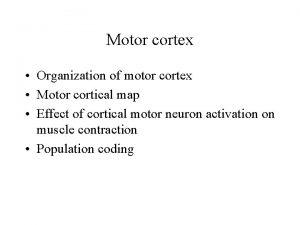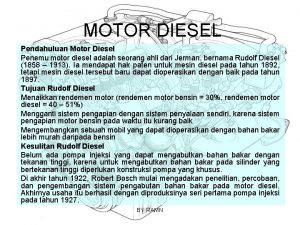Motor Pool and Maintenance Safety and Accident Prevention































































































- Slides: 95

Motor Pool and Maintenance Safety and Accident Prevention

Maintenance-Related Accidents Maintenance-related accidents are responsible for 20 percent of all military on-duty injuries 2

References • 29 Code of Federal Regulations (CFR) 1910, General Industry Standards • AR 385 -10, The Army Safety Program • AR 750 -1, Army Material Maintenance Policy • DA Pam 750 -1, Commanders’ Maintenance Handbook • DA Pam 750 -3, Soldiers’ Guide for Field Maintenance Operations 3

Terminal Learning Objective Action: Explain requirements for motor pool and maintenance safety and accident prevention. Conditions: During group discussions regarding motor pool and maintenance operations. Standard: Requirements include responsibilities, standing operating procedures, and safety precautions. 4

Lesson Data • • Safety Requirements Risk Assessment Environmental Conditions Evaluation – Oral questions – Participation during class discussions 5

Overview • Responsibilities of key maintenance personnel • Standing Operating Procedures (SOPs) • Precautions for hazards found within or around a motor pool and/or maintenance facility • Hazards of specialized equipment and procedures 6

Enabling Learning Objective A Action: Identify the responsibilities of key maintenance personnel within a unit maintenance program. Conditions: Given the titles of key maintenance personnel Standard: Identification must include a minimum of three responsibilities for each as outlined in AR 38510, AR-750 -1, and DA Pam 750 -1. 7

Commander’s Responsibilities • As an Army leader, commander’s responsibilities include: – Protecting personnel, equipment, and facilities – Establishing accountability for safety and occupational health – Implementing safety and occupational health policies 8

Commander’s Responsibilities Continued • Commander’s responsibilities also include: – Integrating Composite Risk Management (CRM) process into mission activities – Emphasizing the importance of safety and maintenance 9

Safety Officer/NCO Responsibilities • Responsibilities include: – Serving as principal advisor to the commander in all safety / occupational health related matters related to mission – Advising and assisting the commander in ensuring CRM is an integral part of the unit’s operations and training – Assisting with hazard identification and assessment tools 10

Supervisor’s Responsibilities • A supervisor’s responsibilities include: – Maintaining a safe and healthful workplace – Inspecting the work area for hazards – Using CRM during planning, preparation, and execution of all operations – Preventing accidents 11

Supervisor’s Responsibilities Continued • A supervisor’s responsibilities also include: – Attending, leading, and supervising preventive maintenance operations – Checking and updating SOPs – Enforcing Army Maintenance Standards – Training operators and crews to operate equipment and perform PMCS properly – Enforcing safety 12

Operators’ and Crews’ Responsibilities • Operator and crew responsibilities include: – Detecting and reporting malfunctions – Operating equipment properly and safely – Knowing their responsibility in achieving the Army Maintenance Standard – Performing Preventive Maintenance Checks and Services (PMCS) 13

Performing PMCS • Cornerstone of the Army Maintenance System • Required by all printed, electronic, and interactive electronic technical manuals (TM) • Must be performed from the applicable TM • Faults detected that violate a safety directive must be corrected 14

Enabling Learning Objective B Action: Describe the requirements for maintenance standing operating procedures (SOPs). Conditions: During group discussions. Standard: Requirements must include the description for the need of SOPs and at least 10 areas that should be addressed in detail as specified in DA Pam 750 -3. 15

Why have a Maintenance Standing Operating Procedure (SOP)? • Required by AR 750 -1 which states: – “SOPs will be established and maintained by all Army organizations and activities performing maintenance operations. ” • Purpose – To formally describe the way a unit performs maintenance 16

Motor Pool and Shop Safety SOPs • DA Pam 750 -3 specifies – Every unit SOP will address safety – Motor pool operations and field maintenance are linked with safety 17

Minimum Areas to Address in SOP • Duties/responsibilities for key unit personnel • How the maintenance platoon is organized • The Army Maintenance Management System (TAMMS) information not covered in DA Pam 750 -8 18

Minimum Areas to Address in SOP Continued • Preventive maintenance checks and services (PMCS) – Procedures for scheduled Field PMCS – Army Oil Analysis Program (AOAP) – Calibration of tools and Test, Measurement, and Diagnostic Equipment (TMDE) 19

Minimum Areas to Address in SOP Continued • Tool accountability and control procedures • Safety requirements to include: – All applicable safety guidance associated with equipment maintenance – HAZMAT and PPE – Lifting and holding device servicing – Chemical Agent Resistant Coating (CARC) 20

Minimum Areas to Address in SOP Continued • Unit maintenance training programs and requirements • Motor pool security • Readiness reporting • Publications • Work order management 21

Minimum Areas to Address in SOP Continued • Equipment classifications • Battlefield damage assessment and repair/recovery (BDAR/R) • Repair parts (Class IX) management • Warranty Management Program 22

Minimum Areas to Address in SOP Continued • Army Record Information Management System (ARIMS) filing system • Equipment winterization/extreme climate program 23

SOP Development Considerations • Maintenance Operations • Safety and protection plans such as: – Fire Prevention Plan – Ground Pre-accident Plan • Past accidents – Lessons learned – Preventive measures 24

Motor Pool and Shop Safety Sample SOPs • Army Knowledge Online (AKO) • U. S. Army Combat Readiness/Safety Center 25

Enabling Learning Objective C • Action: Recommend precautions for hazards found within or around a motor pool and/or maintenance facility. • Condition: During group discussions and viewing photographs of maintenance areas. • Standard: Recommended precautions must be feasible and effective. 26

Recognize Motor Pool and Maintenance Facility Hazards • Walk around outside areas of the facility to notice: – Surface conditions – Use of ground guides – Use of wheel chocks – Protective railings – Hazardous substances 27

Poor Surface Conditions 28

Ground Guides • Required when wheeled and tracked vehicles are: – Backed – Moved within an assembly area or motor pool 29

Ground Guides Continued • Will be properly trained – FM 21 -60 Visual Signals – FM 21 -305 Manual for the Wheeled Vehicle Driver – TC 21 -306, Tracked Combat Vehicle Driver Training 30

Ground Guides Continued • Tracked vehicle movement within an assembly area requires ground guides front and rear 31

Wheel Chocks • Army vehicles will be equipped with properly sized chocks when: – Vehicles are parked on an incline – Maintenance is being performed – Vehicle is parked and a trailer is attached 32

Proper Wheel Chock? Slope Wheel Chock? 33

This is wrong -- why? 34

Protective Railings Elevated platforms (4 feet and above) should be equipped with proper railings and work platforms Correct OSHA required platform and railings 29 CFR 1910 General Industry 35

Report this Hazard to be Corrected 29 CFR 1910 General Industry 36

Hazardous Substances Ensure: • Proper storage, storage containers, and markings • Inventory listing of all hazardous materials • Material Safety Data Sheets (MSDS) are located in area • Signs are posted 37

Material Safety Data Sheets (MSDS) • Must be maintained in the work area where hazardous chemicals are stored or used • Post an inventory list of all chemicals on-hand MSDS 38

Know What’s Stored Hazardous substance? Secondary containment needed? 39

Recognize Motor Pool and Maintenance Facility Hazards • Walk around inside areas of facility to notice hazards associated with: – Roof leaks – Exhaust/Carbon Monoxide – Bay areas – Mezzanine storage areas – Noise exposure – Electrical – Housekeeping and general requirements 40

Roof Leaks • May be common, yet still present a multitude of problems – Slippery work surfaces – Electrical hazards – Health hazards – Pests 41

Exhaust / Carbon Monoxide • Carbon monoxide poisoning may result from exhaust gases • Avoid operating vehicles in a maintenance facility • Use ventilation system • Conduct annual carbon monoxide tests AR 385 -10, 11 -4 k 42

Bay Areas • Pits must be fully covered when not in use • An opening can be no larger than one (1) inch 4 -ft hole is still considered a pit 43

Bay Areas Continued • When the cover is not in place – Opening must be constantly attended by someone – Or be protected by removable standard railings 44

Mezzanine Storage Areas • Structure must be approved by a building official • Post sign showing the load limit and date inspected Non-approved structure 45

Unsafe Overhead Mezzanine 46

Noise Exposure Surveillance Program • When noise equals or exceeds an 8 -hour time-weighted average of 85 decibels, the employer shall: – Develop and implement a monitoring program – Establish and maintain an audiometric testing program 47

Electrical No Cover Broken Cover Exposed Wiring 48

Electrical Panels • Each circuit on the panel must be clearly identified and prominently labeled 49

Electrical Ground Protection Symbol for double insulated Plug with ground prong 50

Housekeeping and General Requirements Violations result in hazards 51

Exits Must provide quick, safe egress UN SA FE !! 52

Hard to Reach Safety Board 53

Blocked Emergency Eyewash Station 54

Blocked Again eyewash station 55

Requirements for Emergency Eyewash Stations • Work areas that may require Emergency Eyewash Stations include: – Battery charging areas – Spraying operations – High dust areas – Dipping operations – Hazardous substances dispensing areas 56

Eyewash Stations Accessibility • Locate as close to the hazard as possible – Be on the same floor as the hazard – Not separated by a partition from the hazardous area – Easily seen by workers • Ensure path is unobstructed between the workstation and the hazard 57

Work Surfaces – Water on Floor Hazardous 58

First Aid Kits Ensure safe for use • Inspect contents regularly • Discard outdated items • Refill kit – Complete – Current Check Exp. Dates 59

Display Signs “A picture is worth a thousand words” 60

Personal Protective Equipment First-line leaders should be involved in personal protective equipment (PPE) selection for their personnel 61

Personal Protective Equipment • When PPE is necessary • What PPE is necessary • How to don, remove, adjust, and wear PPE • The limitations of the PPE • Proper care, maintenance, useful life and disposal of the PPE 62

Enabling Learning Objective D Action: Identify hazards of specialized equipment and procedures. Condition: Given the name and/or photo of equipment or procedure used within maintenance facilities. Standard: Recommendations must be provided with hazard identification. 63

Machine Guarding • Recognize and control hazards • Protect from exposure to unguarded or inadequately guarded machines to avoid: – Amputations – Lacerations – Crushing injuries – Abrasions – Death 64

Machine Guarding Continued • 29 CFR 1910 Requirements – When blades of a ventilation fan are less than 7 feet above the floor or working level, the blades will be guarded • Guard shall have openings no larger than ½ inch opening 65

Machine Guarding Hazards Not Guarded Faulty Guarding 66

Securing Abrasive Wheel Machines Must be bolted to a surface area – work bench or floor 67

Adjusting & Testing Abrasive Wheel Machines NOTE: Full face shields, hearing protection, and gloves must be used 68

Air Compressors • Require scheduled maintenance – Drain water to help protect relief valve – Avoid dangerous pressure levels • Locate outside if possible (noise hazard) 69

Compressed Air • Air receiver shall be equipped with an indicating pressure gage – Do not allow air pressure to exceed 30 pounds per square inch (PSI) – 30 PSI is the maximum for cleaning 70

Compressed Air Continued • Use rubber or other insulating material for hose lines to blow out equipment • Do not use compressed air for cleaning floors • Do not direct air toward others or self 71

Lifting Devices • Reference: TB 43 -0142 Safety Inspections and Testing of Lifting Devices – Cranes – Hoists – Slings – Trucks, Forklift – Jacks and Stands • Inspect every 6 months 72

Lifting Devices Load Testing • Load tests will be clearly marked on the device • Slings, wire ropes, hooks, etc. , used for lifting, must be tagged with due date • Load rating shall become a part of the maintenance records 73

Jack Stands and Floor Jacks • Daily and/or before use inspections – Ensure item is safe for use – Follow appropriate checklist, technical manual (TM) and other information to ensure safety • Periodic inspections every 6 -months 74

Fork Lifts • • Train and certify operators Do not modify or make attachments Examine for defects Know the capacity of the truck Wear seatbelts Ensure reverse alarm works Avoid traveling with elevated load 75

Welding Requirements • Obtain hot work permit before welding operations • Area must be deemed safe for welding • Place shield to protect those passing by the area • PPE includes gloves, apron boots head shield with protective lens 76

Welding Operations • Know what materials are being welded • Certain metals produce fumes that produce a serious health threat to the welder • Wear respiratory protection as needed • No contact lens 77

Improper Procedures • Missing PPE for welding • Lack of fall protection – No : – 3 -point stand – Guardrail system, or – Personal fall arrest system 78

Compressed Gas Cylinders • All personnel who work with or handle pressurized gas cylinders will review AR 700 -68 annually • Maintenance activities will maintain a record of these reviews • Large number of tanks should not be stored in work areas 79

Compressed Gas Storage • Storage areas must be clearly marked and properly secured • Separate cylinders by hazard class – Flammable gas – Nonflammable gas – Poison gas 80

Cleaning Solvents • Use approved, environmental safe cleaning solvents – Not highly toxic or flammable ng o r w ? s e ’ r t a u – Consult applicable TM Wh is pict h t • Ensure MSDS for solvent wi used is available • Wear required PPE 81

Asbestos and Ceramic Fibers • Inhaling asbestos and ceramic fibers can cause serious fibrotic lung disease and lung cancer • Some brake shoes, clutch linings, and engine gaskets contain asbestos or ceramic fibers • Take precautions to reduce exposure 82

Working with Batteries • Army battery program IAW AR 750 -1, Paragraph 8 -20 – Commanders will ensure that all battery shops are operated in an Occupational Safety and Health Organizations/ Environmental Protection Agency compliant manner 83

Working with Batteries Continued • Charge batteries in a well-ventilated, clean, and uncluttered area – Wear chemical splash goggles or a full face shield • Filling Storage Batteries – Wear acid-resistant gloves, chemicalsplash goggles, rubber aprons, and rubber boots with non-slip soles – If available, use a fume hood 84

Storing Batteries • Batteries must have secondary containment to prevent acid leaks • If stored outdoors, they must have overhead cover Improper Storage 85

Lockout – Tagout • Affixed to energy isolating devices • Prevent start up or release of stored energy in order to prevent injury to employees • Prevent activating equipment while it is being worked on 86

Painting Vehicles • Minor paint operations can be conducted indoors • Minor paint operations may be conducted outdoors • As long as repeated operations is not more often than once a week and no more than one body panel • Use proper PPE 87

Tire Cages • Cages should not be bolted down • Training and instructions must be provided • Correct air hose must be used, that is, use a 10 -foot extension with clip on chuck 88

Does Not Meet Specifications UNSAFE FOR USE! 89

Check on Learning Name a Commander’s responsibilities relating to maintenance facilities. – Protecting personnel, equipment, and facilities – Implementing safety and occupational health policies – Integrating the composite risk management process into their mission activities 90

Check on Learning What must operators know to have a successful maintenance program? – Operators must know how to detect and report malfunctions as well as operate equipment properly and safely. 91

Check on Learning What is the objective of the Army’s PMCS program? – The objective is the observation of equipment performance and condition. 92

Check on Learning Name requirements regarding an open pit? – It must be covered when not in use, constantly guarded by someone, or guarded by removable rails 93

Summary • Responsibilities of key maintenance personnel • Standing Operating Procedures (SOPs) • Precautions for hazards found within or around a motor pool and/or maintenance facility • Hazards of specialized equipment and procedures 94

Conclusion Follow the standards! Protect yourself and others! Get the job done safely! 95
 Primary prevention secondary prevention tertiary prevention
Primary prevention secondary prevention tertiary prevention Army motor pool sop
Army motor pool sop Accident prevention tags may be used
Accident prevention tags may be used Accident prevention signs and tags
Accident prevention signs and tags Sign with white background with a green panel
Sign with white background with a green panel Accident prevention manual
Accident prevention manual Theories of accident prevention
Theories of accident prevention East carolina pool and spa
East carolina pool and spa Injury prevention safety and first aid
Injury prevention safety and first aid Needlestick safety and prevention act
Needlestick safety and prevention act Sb 442
Sb 442 Fire hose reel signage standards
Fire hose reel signage standards What is a motor unit
What is a motor unit Pony motor starting method
Pony motor starting method Pony motor starting synchronous motor
Pony motor starting synchronous motor Ac motor vs dc motor
Ac motor vs dc motor Ee 216
Ee 216 Colorado state patrol motor carrier safety
Colorado state patrol motor carrier safety Fmcsr 396
Fmcsr 396 Motor vehicle safety regulations canada
Motor vehicle safety regulations canada Georgia motor carrier compliance division
Georgia motor carrier compliance division Which display mode is allowed for proper navigation?
Which display mode is allowed for proper navigation? Qbs safety care
Qbs safety care Personal safety vs process safety
Personal safety vs process safety Safety assessment for ind safety reporting
Safety assessment for ind safety reporting Basic safety construction site safety orientation
Basic safety construction site safety orientation Basic safety construction site safety orientation
Basic safety construction site safety orientation Essence and accident
Essence and accident Army accident reporting
Army accident reporting Approach and landing accident reduction
Approach and landing accident reduction Expanding the talent pool recruitment and careers
Expanding the talent pool recruitment and careers Identify a warning sign of a weak talent bench
Identify a warning sign of a weak talent bench Expanding the talent pool recruitment and careers
Expanding the talent pool recruitment and careers An ordering and receiving materials cost pool
An ordering and receiving materials cost pool Spill response plan example
Spill response plan example Prevention and combating of corrupt activities act summary
Prevention and combating of corrupt activities act summary Colorado division of fire prevention and control jprs
Colorado division of fire prevention and control jprs National guidance on falls prevention scotland
National guidance on falls prevention scotland Puncture resistant container
Puncture resistant container Chapter 26 infectious disease prevention and control
Chapter 26 infectious disease prevention and control Chapter 19 disease transmission and infection prevention
Chapter 19 disease transmission and infection prevention Upaya promotif dan preventif menurut leavel dan clark
Upaya promotif dan preventif menurut leavel dan clark European centre for disease prevention and control
European centre for disease prevention and control Deadlock prevention avoidance and detection
Deadlock prevention avoidance and detection Health promotion and levels of disease prevention
Health promotion and levels of disease prevention Policy on harassment prevention and resolution
Policy on harassment prevention and resolution Deadlock detection prevention and avoidance
Deadlock detection prevention and avoidance What is the subpart for fire protection and prevention
What is the subpart for fire protection and prevention Chapter 19 disease transmission and infection prevention
Chapter 19 disease transmission and infection prevention Health promotion and levels of disease prevention
Health promotion and levels of disease prevention Professional nursing practice: concepts and perspectives
Professional nursing practice: concepts and perspectives School crisis prevention and intervention
School crisis prevention and intervention 1910 fire extinguisher
1910 fire extinguisher Serious injury and fatality prevention
Serious injury and fatality prevention Deadlock prevention and avoidance
Deadlock prevention and avoidance Chapter 16 infection prevention and control
Chapter 16 infection prevention and control Abuse prevention and response protocol
Abuse prevention and response protocol Loss prevention and security in hotels
Loss prevention and security in hotels Prevention and control of poliomyelitis
Prevention and control of poliomyelitis Prevention and control of poliomyelitis
Prevention and control of poliomyelitis Ics diabetes
Ics diabetes Alberta screening and prevention program
Alberta screening and prevention program Serious injury and fatality prevention
Serious injury and fatality prevention Kf case study memory
Kf case study memory The equation illustrates that momentum is
The equation illustrates that momentum is Anupriya maharshi accident
Anupriya maharshi accident Coil accident
Coil accident Sophie delezio second accident
Sophie delezio second accident Rovos rail derailment
Rovos rail derailment Accident or on purpose activity
Accident or on purpose activity Sacha distel accident
Sacha distel accident Pre accident plan
Pre accident plan Accident past participle
Accident past participle Parent de diana spencer
Parent de diana spencer Campinas 2005 accident
Campinas 2005 accident Dr raymond thal
Dr raymond thal Maharshi amara
Maharshi amara Near miss to accident ratio
Near miss to accident ratio Denise wagoner
Denise wagoner Kelly monaco scuba diving accident
Kelly monaco scuba diving accident What are the types of collision
What are the types of collision Mobile scaffolding hazards
Mobile scaffolding hazards Accident fromagerie caillage
Accident fromagerie caillage Tu quoque fallacy
Tu quoque fallacy Ignoratio elenchi example
Ignoratio elenchi example Hse incident reporting flow chart
Hse incident reporting flow chart Bhn platform accident
Bhn platform accident Dodi al fayed
Dodi al fayed Conversiune logica
Conversiune logica Raidurgam fire accident
Raidurgam fire accident Andrew cornelius accident
Andrew cornelius accident Accident or on purpose activity
Accident or on purpose activity Accident weed diagram
Accident weed diagram Welding accident case study
Welding accident case study 5-9 accident investigation data answers
5-9 accident investigation data answers They still haven't found out what caused the accident
They still haven't found out what caused the accident


